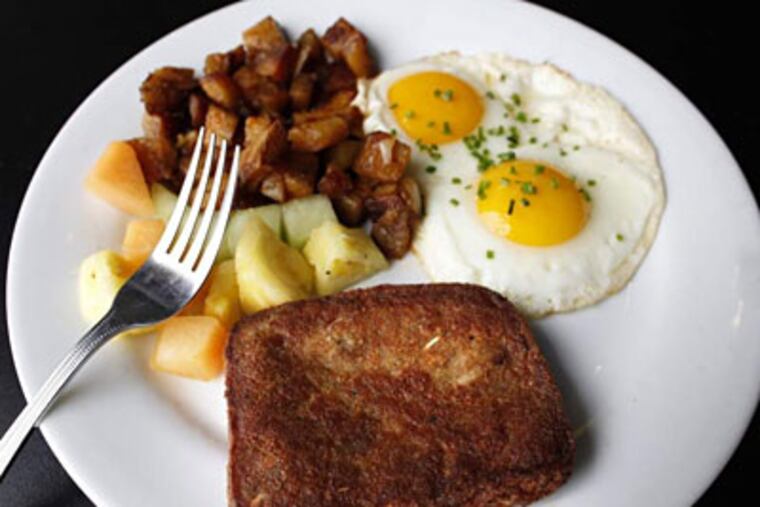Scrapple from scratch at Cafe Estelle
The scrapple education of Marshall Green began in earnest three years ago, maybe a little longer. It was a mysterious meat to him, the great-grandson of the operator of a Jewish deli, Abe’s by name, which eventually begot Murray’s, the Bala Cynwyd fixture.

The scrapple education of Marshall Green began in earnest three years ago, maybe a little longer.
It was a mysterious meat to him, the great-grandson of the operator of a Jewish deli, Abe's by name, which eventually begot Murray's, the Bala Cynwyd fixture.
Green had opened his own place, Cafe Estelle, on a hidden stretch of Fourth Street, south of Spring Garden. And soon it became known for extraordinary brunches (the "Spring Scramble" last week featured fiddlehead ferns, English peas and asparagus), a smoker out back, and in a nod to his forebears, excellent sweet and sour beef-cabbage soup.
One day his sous chef got a bee in his bonnet. He wanted to make a batch of scrapple, which he proceeded to do using shoulder cuts of wild boar, and pig parts, including ears and snouts, procured from the Asian grocery up the street.
Long story short, it sold like hotcakes. Its first time as a breakfast special, 35 customers ordered it. By 10 in the morning!
Such a number is not lost on a chef-owner. House-made scrapple marched straight onto the menu, one more entry (and a lightly-crisped, black-steel-pan seared, lush-textured, delicately seasoned one) in the scrapple revival afoot in the city.
At short-lived MidAtlantic in West Philadelphia, a crab version surfaced, hinting vaguely of crab cake. Oysters got into the act at Oyster House. And in one jarring reinterpretation, Silk City Diner took the rustic, farm-county cousin uptown, imbuing it with foie gras, and sometimes asparagus, and — talk about mystery ingredients! — occasionally red quinoa.
The sleepy slab was upstaging sunnyside-up eggs, strutting like a Mummer, busting out of centuries of culinary solitary.
On Fourth Street, Marshall Green had joined the revival, but not the parade. His scrapple wouldn't be chic. He'd do it old school — break down the whole pig, use the trotter, shoulder and head meat, and that (and of course, pork stock, cornmeal slurry, and seasoning) was all, folks.
And nobody was laughing.
•
After lunch service one afternoon last week, the pig was sprawled on the butcher block counter in Cafe Estelle's back kitchen, a 148-pounder, eviscerated, hairless and scrubbed pink.
It was a Yorkshire-Hampshire cross, pastured at a Green Village Co-op farm in North Jersey, a bit younger than your average mass-produced pig, evidenced by its paler meat.
Green's scrapple demand has remained steady. So he went whole hog a few years ago. Every six weeks, he divests a pig of its more esteemed parts (for other dishes), then mines its less exalted precincts.
The yield is enough for 40 pounds of scrapple, or more than 165 orders, a few reserved for a hangover sandwich said to have potent restorative powers. (That would be pan-seared scrapple, and two fried eggs with arugula, red onion, and grainy mustard on a bagel.)
Scrapple-making is not a precise art. Typically, it involves the remnants of the pig — the head, the feet, and liver left after even the sausage meat has been harvested. The next defining characteristic? A 40 percent proportion of grain, usually cornmeal (Green uses bagged polenta), buckwheat, or both.
The gelatinous pork broth and cereal are what stiffens the stuff up in loaf pans. Green freezes it in slices (he'll sell you some to take away at $7.50 a pound), then thaws them, lightly flours them and — rejecting that most vile of scrapple short cuts — eschews the greasy deep-fat fryer, gently crisping them instead in stove-top, steel pans.
•
Before surplus pork turned scrapple into an industrial product after the Civil War, it was the by-product of cool fall butchering days on the farms of Lancaster County's frugal Pennsylvania Dutch.
Green hews to the earlier tradition. No crabmeat! No quinoa! And while other house-made scrapple kitchens — Amis trattoria's on 13th Street, for one — do such a brisk business that they now order pork shoulders and livers, Green has time to simmer the pig's backbone and leg bones for stock overnight. (That stock has its own secondary use; it makes a mean pea soup.)
At the butchering table, Green works the boning knife. The inventory begins to line up — kidneys as purple as plums, leaf fat that he'll render for lard, sleek tenderloins, and loins for Milanese pork on salads and pork cutlet sandwiches with broccoli rabe.
The thin skirt steaks will go home with him for tacos. A cleaver takes the head off. He cuts out the shoulder, the belly to make pancetta, the ribs to barbecue, meat for sausage.
He pours kosher salt over the chunked leg, "butt" shoulder, and kidney, and over the hog's head until it is capped with snow. "It's my inner Jew coming out," says Green, now 31. "I think if you put enough kosher salt on a pig you can turn it kosher."
The salt is half the cure. The other half is a blend of garlic, thyme, black pepper, allspice, star anise, fennel seed, yellow and black mustard seed, and raw sugar, the cafe's aromatic signature.
The next morning, it's rinsed off, and the meat is simmered for close to five hours in the stock. It is soft and slippery as Green picks it apart. Then it's forced through a coarse grinder — the pig ears leaving flecks of white — and combined in a big Hobart mixer with the cooked cornmeal polenta porridge.
Finally, before it sets up, Green hurriedly spoons it into long loaf pans.
Made this way, using a few leaner cuts, scrapple has, by one accounting, about half the protein and half the fat of fresh ham.
Marshall Green's great-grandfather would be — well, it's hard to say.